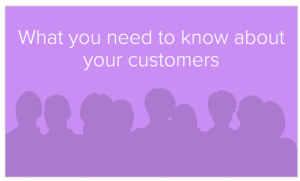Customers, customers, customers. They are the lifeblood of your successful food truck (or any) business.
They confuse you. They make you happy. They make you frustrated. But, you’ve got to love them. They buy your product. They support your company. And if you’re lucky, they tell friends about the business and may even become friends of yours.
But you have to know who your customers are, before you do anything else.

Why is target market important?
1. It helps price your product
You’re likely targeting high-end consumers, but some of you may not be. If your $9/bottle hot sauce is placed in a convenience store, it probably won’t move off the shelf. And when your product doesn’t move off the shelf, you eventually get booted and have to take back the product that hasn’t sold. Keep this in mind when pricing your product. Are moms willing to pay a premium for snacks for their kid? Are football-watching men going to pay for your premium beef jerky? Use your target market to influence your pricing structure. This in turn…..
2. It helps influence your marketing & messaging
The words, logo, packaging design, website, business cards, etc. All of them should be influenced by your customer. If they’re in their 50’s, copy should speak to them and be larger. If they’re in their 20’s, copy can be edgy, packaging can be bright, and marketing can be, well, out-of-the-box.
This way, when you get approached by food bloggers, create sell sheets or go to trade shows, you already know what your marketing message is going to be. It helps you focus on attracting your core customers. Customers who are going to get behind you – and your brand – and tell other people.
So, what do you need to know about them?
1. Their age
How old – or how young – are your customers? Age influences how much money your customers have to spend on your product. Plus, it determines what health benefits are important to them.
2. Their disposable income
This is a no-brainer. Your target market needs to have enough money to buy your product. If they’re just out of college, they’re saddled with college debt. If they’re stay-at-home mom’s they may have a bit more money to spend on what they feed their child. Keep this in mind when you’re pricing your product.
If you market to everyone, you market to no one.
3. Where they shop
If your product isn’t in stores where your target market shops, it might flop. Ask customers where they shop and what stores your product would do well in. You’d be surprised – they are more than willing to help you out.
4. What they like to do in their spare time
Free time activities helps influence where you show up on the weekends with your product. Plus, it helps identify what sort of charity events you might want to participate in, too.
5. How many kids they have
Kids dictate a large number of purchases in many households. They simply point and mom or dad purchases. If you’ve got a product targeted towards kids, make sure it’s healthy (please), and find a way to get your product at their eye-level (notice how all the cereal boxes of larger brands are down-low?)
So – that’s awesome. You need to learn more about your customer and it’s going to help you market your product. But, how do you actually do it? What tools are out there? Luckily, I compiled a list of 5 resources to help you get demographic data on your customers:
How do you get information about your customers?
Over the years, I’ve used several tools to help inform me about my customer. Here are my top 3:
1. ZipSkinny
I first learned about this tool in college in my foundations of marketing course. It’s quick, free demographic data. Get ages, incomes, gender splits, and more. Check it out at ZipSkinny.com
2. SocialExplorer
I actually just found this tool a few weeks ago. It’s FULL of data about customers in your area. For me, it helps to identify what cities to focus on to expand my mustard business and how I can find customers willing to pay a premium for gourmet mustard. Check it out at SocialExplorer.com
3. Start a conversation with your customer (whoa, what?)
When you’re at events, talk to customers. Go beyond “your total comes to $12.” and ask them about their life. Listen. Listen to your customers. See what they do for fun. See where they shop. And most importantly listen to their words. Then, use those words in your website copy. See, it’s not all magic!
Customers are the lifeblood of your business. Without them, you have no business. Find out as much as you can about your customer and you’ll suddenly be increasing your sales without even knowing it.

Leave A Comment